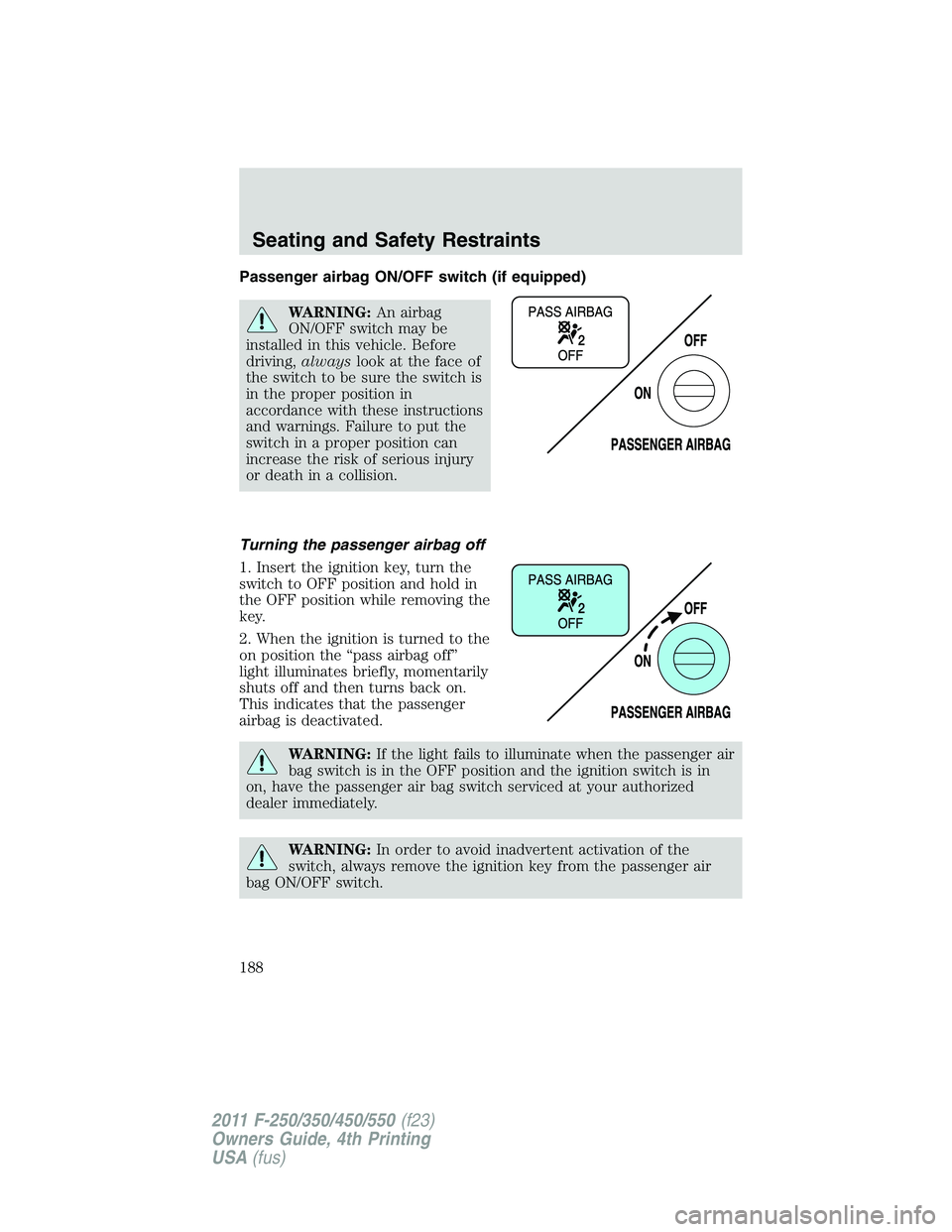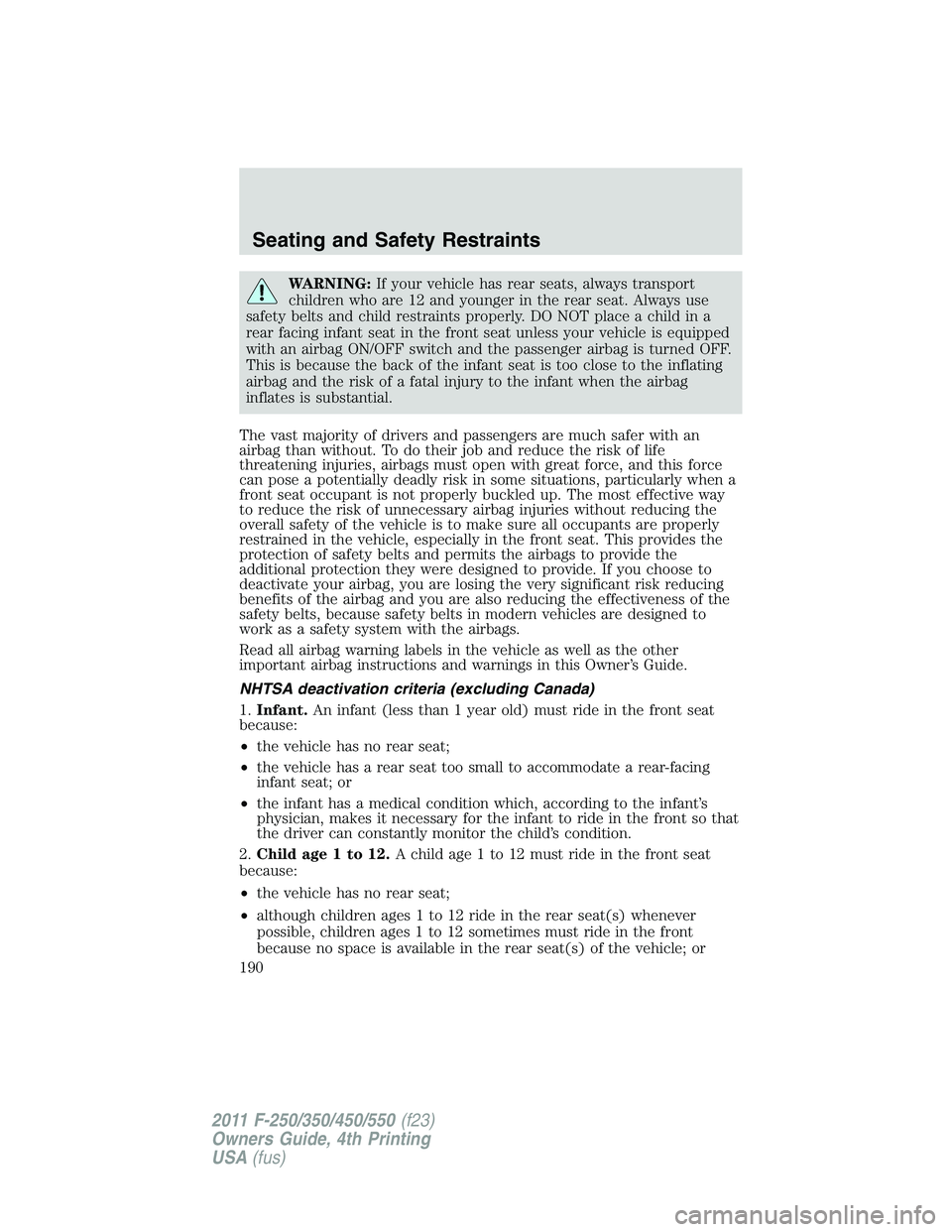Page 17 of 449

WARNING: Driving a vehicle with the brake system warning
light on is dangerous. A significant decrease in braking
performance may occur. It will take you longer to stop the vehicle.
Have the vehicle checked by your authorized dealer. Driving extended
distances with the parking brake engaged can cause brake failure and
the risk of personal injury.
Anti-lock brake system: If the
ABS light stays illuminated or
continues to flash, a malfunction has
been detected, have the system
serviced immediately by your
authorized dealer. Normal braking is still functional unless the brake
warning light also is illuminated.
Airbag readiness: If this light fails
to illuminate when the ignition is
turned to on, continues to flash or
remains on, have the system
serviced immediately by your
authorized dealer. A chime will sound if there is a malfunction in the
indicator light.
Safety belt: Reminds you to fasten
your safety belt. A Belt-Minder �
chime will also sound to remind you
to fasten your safety belt. Refer to
the Seating and Safety Restraints
chapter to activate/deactivate the Belt-Minder � chime feature.
Charging system: Illuminates when
the battery is not charging properly.
If it stays on while the engine is
running, there may be a malfunction
with the charging system. Contact your authorized dealer as soon as
possible. This indicates a problem with the electrical system or a related
component.
Engine oil pressure (RTT and
static warning light): Displays
when the oil pressure falls below the
normal range. Refer to Engine oil
in the Maintenance and Specifications chapter.ABSInstrument Cluster
17
2011 F-250/350/450/550 (f23)
Owners Guide, 4th Printing
USA (fus)
Page 176 of 449

Reasons given... Consider...
“I have an airbag” Airbags offer greater protection when
used with safety belts. Frontal airbags
are not designed to inflate in rear and
side crashes or rollovers.
“I’d rather be thrown clear” Not a good idea. People who are
ejected are 40 times more likely
to DIE. Safety belts help prevent
ejection, WE CAN’T “PICK OUR
CRASH”.
WARNING: Do not sit on top of a buckled safety belt or insert a
latchplate into the buckle to avoid the Belt-Minder � chime. To
do so may adversely affect the performance of the vehicle’s airbag
system.
Deactivating/activating the Belt-Minder � feature (Driver only)
Note: If you are using MyKey � , the Belt-Minder � cannot be disabled.
Also, if the Belt-Minder � has been previously disabled, it will be
re-enabled during the use of MyKey � . Refer to MyKey � in the Locks and
Security chapter.
The Belt-Minder � feature can be deactivated/activated by performing the
following procedure:
Before following the procedure, make sure that the following conditions
are met:
• the parking brake is set
• the gearshift is in P (Park)
• the ignition switch is in the off position
• all vehicle doors are closed
• the driver’s safety belt is unbuckled
• the parklamps/headlamps are in the off position
WARNING: While the design allows you to deactivate your
Belt-Minder � , this system is designed to improve your chances of
being safely belted and surviving an accident. We recommend you
leave the Belt-Minder � system activated for yourself and others who
may use the vehicle. To reduce the risk of injury, do not
deactivate/activate the Belt-Minder � feature while driving the vehicle.Seating and Safety Restraints
176
2011 F-250/350/450/550 (f23)
Owners Guide, 4th Printing
USA (fus)
Page 188 of 449

Passenger airbag ON/OFF switch (if equipped)
WARNING: An airbag
ON/OFF switch may be
installed in this vehicle. Before
driving, always look at the face of
the switch to be sure the switch is
in the proper position in
accordance with these instructions
and warnings. Failure to put the
switch in a proper position can
increase the risk of serious injury
or death in a collision.
Turning the passenger airbag off
1. Insert the ignition key, turn the
switch to OFF position and hold in
the OFF position while removing the
key.
2. When the ignition is turned to the
on position the “pass airbag off”
light illuminates briefly, momentarily
shuts off and then turns back on.
This indicates that the passenger
airbag is deactivated.
WARNING: If the light fails to illuminate when the passenger air
bag switch is in the OFF position and the ignition switch is in
on, have the passenger air bag switch serviced at your authorized
dealer immediately.
WARNING: In order to avoid inadvertent activation of the
switch, always remove the ignition key from the passenger air
bag ON/OFF switch.Seating and Safety Restraints
188
2011 F-250/350/450/550 (f23)
Owners Guide, 4th Printing
USA (fus)
Page 190 of 449

WARNING: If your vehicle has rear seats, always transport
children who are 12 and younger in the rear seat. Always use
safety belts and child restraints properly. DO NOT place a child in a
rear facing infant seat in the front seat unless your vehicle is equipped
with an airbag ON/OFF switch and the passenger airbag is turned OFF.
This is because the back of the infant seat is too close to the inflating
airbag and the risk of a fatal injury to the infant when the airbag
inflates is substantial.
The vast majority of drivers and passengers are much safer with an
airbag than without. To do their job and reduce the risk of life
threatening injuries, airbags must open with great force, and this force
can pose a potentially deadly risk in some situations, particularly when a
front seat occupant is not properly buckled up. The most effective way
to reduce the risk of unnecessary airbag injuries without reducing the
overall safety of the vehicle is to make sure all occupants are properly
restrained in the vehicle, especially in the front seat. This provides the
protection of safety belts and permits the airbags to provide the
additional protection they were designed to provide. If you choose to
deactivate your airbag, you are losing the very significant risk reducing
benefits of the airbag and you are also reducing the effectiveness of the
safety belts, because safety belts in modern vehicles are designed to
work as a safety system with the airbags.
Read all airbag warning labels in the vehicle as well as the other
important airbag instructions and warnings in this Owner’s Guide.
NHTSA deactivation criteria (excluding Canada)
1. Infant. An infant (less than 1 year old) must ride in the front seat
because:
• the vehicle has no rear seat;
• the vehicle has a rear seat too small to accommodate a rear-facing
infant seat; or
• the infant has a medical condition which, according to the infant’s
physician, makes it necessary for the infant to ride in the front so that
the driver can constantly monitor the child’s condition.
2. Child age 1 to 12. A child age 1 to 12 must ride in the front seat
because:
• the vehicle has no rear seat;
• although children ages 1 to 12 ride in the rear seat(s) whenever
possible, children ages 1 to 12 sometimes must ride in the front
because no space is available in the rear seat(s) of the vehicle; orSeating and Safety Restraints
190
2011 F-250/350/450/550 (f23)
Owners Guide, 4th Printing
USA (fus)